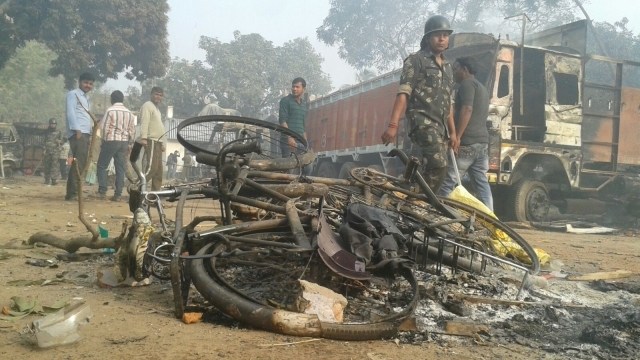By SK Abid Hasan
“Is this Bangladesh? Or is it Pakistan?” echoed somebody from the mob gathered on the road blocking our entry into Dhulagarh. Yes, Dhulagarh: a nondescript, semi-urban town 25 km west of Kolkata, is sectioned off between parties. This is an arterial road that leads to the Dhulagarh bazaar. Flags of Congress, Forward Bloc and Shiv Sena line up when you enter the road. Then they give way to Shiv Sena flags, planted at regular intervals.
As soon as we enter this riot-hit town, our car is ground to a halt by a small crowd on the road. An agitated group of women, supported by some men and young boys, are trying to block the road, demanding release of Hindu men detained by the police.
Dhulagarh saw intense violence, arson and destruction post Celebration of Milad-un-Nabi, to mark the birthday of the Prophet Mohammed, on December 13.
Both communities tell the same story with a few significant differences. Around 11 am December 13, the annual procession to celebrate Milad un Nabi was passing through the town. Trouble began when it reached the Annapurna Club, a local landmark controlled by BJP.
According to Shamsher Ali Lashkar, Panchla block secretary of the Trinamool Congress and a resident of Jairampur, it was the BJP who provoked Muslims. Even before the procession kick-started on December 13, a minor altercation took place at Annapurna Club on over the hoisting of Islamic flag considered by the Hindus to be the Flag of Pakistan.
Tensions were already high when the procession wavered through the Hindu dominant area of Narayan Tala. “We were taking the funeral of my brother near Annapurna Club and the procession was playing loud songs. When they were stopped, a fight broke out. An hour later, they started throwing bombs, targeting houses in Jairampur and Dewanghat.” remarked the brother of the deceased who refused to be named.
According to Zarina Begum, one of the most affected financially, “About 15 to 20 boys towards the end of procession were caught by the boys at the Annapurna Club. The club boys threw stones, people were injured and the rally dispersed. Then people started throwing bombs. 8 to 10 houses of both communities were damaged.”
But Keshto Mullick, a victim, paints a different story. He says, “Muslims had created a blockade. 5-7 Hindus asked them to clear the road. An altercation took place and the Muslims started bombing us.”
Finding the exact source for such a complex situation is extremely difficult but one thing everybody, Hindu or Muslim, accepts that country-made bombs, a political feature famous in Bengal, has made its way into communal riot. Sec 144 was still in place when our team, Dynt Media, visited the second time on RAF (Rapid Action Force) was deployed. Police protection upped. On December 14, Dhulagarh saw the most devastating riots in it’s long tolerant history.
Both communities use a very sophisticated political language that reinforces old cultural and political stereotypes. The Hindu attackers used arrows, say Muslim families. The Muslims came with swords, say Hindus.
While everyone agrees unanimously that the Muslim mob armed with petrol and bombs were outsiders, the Hindu community’s repeated assertion that outsiders came from Metiaburz appeared politically rehearsed. They seemed to have borrowed from the Bhadrolok ignorance in Calcutta that the migrant Muslims living in Metiaburz are Pakistanis. Hence, a phobia has been created by RSS, who maintain some presence in the area since 1990s, that Dhulagarh is turning into Pakistan.
Both Panchla and Sankrail Vidhan Sabha saw the Left Front as runner up in 2016 assembly elections. But the political color on ground had changed.
Saffron flags and BJP’s symbol dotted walls and poles. The person guiding us, Mahanta Paramanik proudly said: “This is a BJP stronghold, I am a party cadre too.” Arun Pramanik claimed he had voted for the Left in the past but now supported the saffron party. A young man, who works with an IT company in Kolkata, later said: “Here Hindus means BJP now!” So clearly there is an attempt to polarise a politically diverse public on grounds of religion. A fact reinforced by Hafizul Malik. “there is an attempt to convert the community 100% to a political party,” he said. He further stated that with any communal riot some big shot political leader is always at the helm to steer communal sentiments for personal advantage.
Dhulagarh has a mixed population of upper castes, Dalits, OBCs Hindus and Muslims. The economy of Dhulagarh has been crippled. State government statistics say there are 350 functional units in the Howrah clusters, of which locals estimate about 100 are in Dhulagarh. The Howrah units employ more than 9,000 people, and the average investment in each plant and machinery is calculated at Rs 5 lakh. Majority belonging to Muslim who are involved in Zari and Embroidery Industry. Economic jealousy as a possible factor cannot be ruled out.
But to explore the prime reason behind this violence we need to go back further than December 13. Traditionally, Dhulagarh didn’t seen any Milad-un-Nabi procession during left rule. It was new addition that was bound to ruffle some feathers in a State where any cultural or religious assertion by Muslims is treated with suspicion. A meeting was held in Natibpur to change the route of the rally and include the Hindu belt around Narayantala in Sankrail constituency.
Permission for the rally was given by Panchla administration which is a part of the local MLA Gulshan Mullick’s constituency. A mini altercation took place on December 13 which resulted in full blown riots on December 14. It has been alleged that RAF had been lifted by local MlA Gulshan Mullick who argued that central forces were harassing the common public.
The documentary, produced and directed by Dynt Media, is an attempt to delve deeper into the issue, and understand what happened in Dhulagarh.


